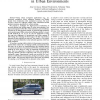Free Online Productivity Tools
i2Speak
i2Symbol
i2OCR
iTex2Img
iWeb2Print
iWeb2Shot
i2Type
iPdf2Split
iPdf2Merge
i2Bopomofo
i2Arabic
i2Style
i2Image
i2PDF
iLatex2Rtf
Sci2ools
RSS
2007
2007
Map-Based Precision Vehicle Localization in Urban Environments
Abstract— Many urban navigation applications (e.g., autonomous navigation, driver assistance systems) can benefit greatly from localization with centimeter accuracy. Yet such accuracy cannot be achieved reliably with GPS-based inertial guidance systems, specifically in urban settings. We propose a technique for high-accuracy localization of moving vehicles that utilizes maps of urban environments. Our approach integrates GPS, IMU, wheel odometry, and LIDAR data acquired by an instrumented vehicle, to generate high-resolution environment maps. Offline relaxation techniques similar to recent SLAM methods [2, 10, 13, 14, 21, 30] are employed to bring the map into alignment at intersections and other regions of self-overlap. By reducing the final map to the flat road surface, imprints of other vehicles are removed. The result is a 2-D surface image of ground reflectivity in the infrared spectrum with 5cm pixel resolution. To localize a moving vehicle relative to these maps, we pres...
| Added | 30 Oct 2010 |
| Updated | 30 Oct 2010 |
| Type | Conference |
| Year | 2007 |
| Where | RSS |
| Authors | Jesse Levinson, Michael Montemerlo, Sebastian Thrun |
Comments (0)

